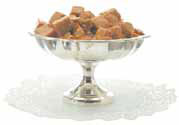Behold, the age of the instant connoisseur
Updated: 2013-03-11 13:36
(The New York Times/China Daily)
|
|||||||||||
The Nobu Hand Roll Box is a kit that contains everything needed to make sushi for 10 to 12 people at home. Now, even novice chefs can create a masterpiece and feel as if they have gained knowledge of an art. The wooden box, meticulously arranged with compartments for 20 ingredients, is $550. For another $350, a Nobu sushi expert from the acclaimed restaurants will come to your home for personalized instruction, so you, too, can become a connoisseur, using seafood that might be difficult to find elsewhere.
 |
|
A gourmet "treat"? It looks like foie gras, but it's dog food. Tests reveal many people can't tell the difference. Tony Cenicola / The New York Times |
Driven by consumerism and a market saturated with labels selling lifestyles, becoming a connoisseur seems easy. Once associated with serious knowledge and appreciation of the high arts, connoisseurship is now applied to everyday objects: cupcakes and coffee, pens and watches, cars and couches.
We "see every item we place in our grocery basket or Internet shopping cart as a reflection of our discrimination and taste," J. Peder Zane wrote in The Times. Once considered elitist or imaginary, connoisseurship is a "vital expression" of how many of us want to see, and distinguish, ourselves.
Decorative crafts have surged in popularity among Swiss watchmakers who are applying age-old artistic skills to high-end watches. They're using traditional engraving techniques and marquetry, reported The International Herald Tribune. There is a "real appreciation right now for high-quality work done by hand," Pierre Rainero, a director at Cartier, told The Tribune.
But Thomas Frank, who has written about consumer culture, told The Times: "It's not about the search for quality, but buying things that make you feel good about yourself. It's about standing apart from the crowd, demonstrating knowledge, hipness."
And it's on display in the front row of every fashion show. Once reserved for members of fashion's old guard, the front row has morphed into a platform for bloggers, reality-TV personalities and wannabes showing off their personal brand, many hoping to foster a career as someone in-the-know.
One new face in the front row is Andy Torres, who went from a blogger of Style Scrapbook to a judge on "Elle Mexico Disena," a fashion competition on television. Her blog, popular with Latinas, had attracted attention after she posted images of herself. Her look is clashing patterns and graphic accents.

Having a recognizable image gives the impression that you may be worth talking to, or about, Daniel Saynt, a founder of Socialyte, an agency that connects tastemakers with brands, told The Times, "even if nobody actually knows who you are."
And perhaps even if you aren't really discerning. Dan Ariely, a professor of psychology at Duke University in North Carolina, told The Times that his experiments with people interested in wine revealed that they couldn't tell the difference between whites and reds. Similarly, tests have found that many people can't tell the difference between foie gras and dog food, wrote Mr. Zane.
But who can say what's what, as Europeans fret over horse meat, and a study reveals that fish sold in American restaurants, markets and sushi bars are often not what the label says?
Kimberly Warner, chief author of the study by Oceana, a nonprofit, told The Times, "Even a relatively educated consumer couldn't look at a whole fish and say, 'I'm sure that's a red snapper and not lane snapper.'"
Sushi, anyone?
Anita Patil
|
|
|
Related Stories
Nabe at nobu 2012-11-25 17:18
Celebs arrive at the Golden Globe Awards Party Honoring Young Hollywood at Nobu in West Hollywood 2009-12-10 10:48
Chic sushi 2012-11-16 17:23
Super sushi 2012-09-17 16:09
Japanese cuisine: Shota Muni Sushi & Grill 2012-07-16 16:43
Today's Top News
Police continue manhunt for 2nd bombing suspect
H7N9 flu transmission studied
8% growth predicted for Q2
Nuke reactor gets foreign contract
First couple on Time's list of most influential
'Green' awareness levels drop in Beijing
Palace Museum spruces up
Trading channels 'need to broaden'
Hot Topics
Lunar probe , China growth forecasts, Emission rules get tougher, China seen through 'colored lens', International board,
Editor's Picks

|

|

|

|

|

|







